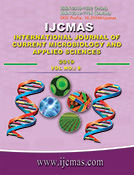


 National Academy of Agricultural Sciences (NAAS)
National Academy of Agricultural Sciences (NAAS)

|
PRINT ISSN : 2319-7692
Online ISSN : 2319-7706 Issues : 12 per year Publisher : Excellent Publishers Email : editorijcmas@gmail.com / submit@ijcmas.com Editor-in-chief: Dr.M.Prakash Index Copernicus ICV 2018: 95.39 NAAS RATING 2020: 5.38 |
A study was conducted to know the mortality pattern in wild animals received from rescue teams in Non Protected Areas of Territorial Forest Division Jabalpur, Madhya Pradesh. A total of 104 deaths were recorded in seventeen different species of wild animals during the period from April 2015 - March 2017. The cause specific mortality was determined on the basis of data available from primary and secondary resources. The history and patho-anatomical changes observed at necropsy were recorded among animals brought at the School of wildlife Forensic and Health, NDVSU, Jabalpur, MP, India. The prime cause of deaths among wild animals were traumatic shock (42.31%), followed by respiratory failure (15.38%), drowning (13.46%), hypovolemic shock (3.85%), lung oedema (1.92%) and septicaemia (1.92%), while capture myopathy, electrocution and heat stroke were also reported each at the level of (0.96%). Remaining 18.27% of the carcasses showed autolytic changes. It is necessary to conduct periodic studies on the mortality pattern among wild animals to know the factors affecting their survival and take steps to prevent large scale morbidity and mortality. The study also emphasises the significance of scientific handling during rescue operations in prevention of animal mortalities at Territorial Forest Divisions.
 |
 |
 |
 |
 |